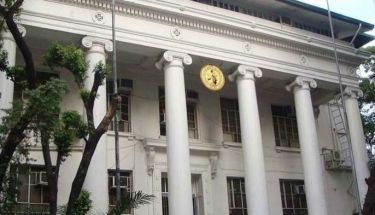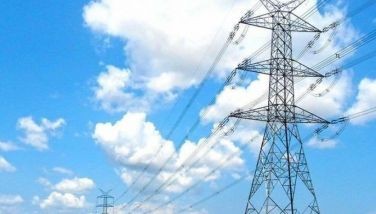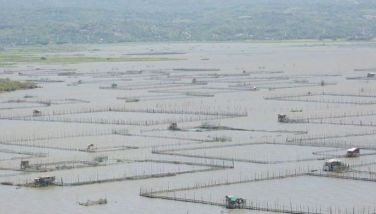40,000 flee from Mayon slopes
August 10, 2006 | 12:00am
LEGAZPI CITY — Rescuers yesterday raced the clock to get stragglers away from rumbling Mayon volcano, with nearly 40,000 people so far fleeing the danger zone.
A two-day effort by the military and the city government has seen 39,278 people safely evacuated from villages surrounding the scenic mountain, the most active volcano in the Philippines, the Provincial Disaster Coordinating Council (PDCC) said.
The evacuees were moved from 25 villages near Mayon, in Albay province, to 20 evacuation centers and more are ready to go quickly in the event of a massive explosion, said Jukes Nuñez of the PDCC.
Albay Gov. Fernando Gonzales reported that the number of evacuees will increase as 8,000 more residents living within Mayon’s danger zone were finally convinced to proceed to safer areas.
"We’re almost finished with the evacuation," he said in reports to the National Disaster Coordinating Council (NDCC). Gonzales chairs the Albay PDCC.
"We are ready for the eruption," he said. "Right now, our efforts are being streamlined from evacuation to relief."
Gonzales added that there are enough supplies for the displaced Mayon residents.
"For the time being, food is not the problem," Legazpi City Mayor Noel Rosal said, though he also appealed for help from the national government because the evacuation and relief effort will deplete the city’s calamity fund.
"We can sustain this until the end of the week. The only problem here is the problem of congested rooms. We might have to open new rooms so epidemics won’t occur," he said.
Rosal said he expects President Arroyo to announce aid from the national government when she visits the evacuees this weekend.
Relief agencies and evacuees are bracing for a long stay in schoolhouses that are now makeshift evacuation centers. The cost of housing and feeding the 10,802 evacuees in the evacuation centers prior to yesterday’s influx was estimated at P367,000 a day.
Schoolrooms are housing up to 30 evacuees who sleep on the floor and are fed with canned meat and instant noodles.
Local officials, though, are experienced in dealing with Mayon, which has erupted around 50 times in the past 400 years, most recently in 1993, when 77 people died.
The officials said their main problem now is dissuading residents from returning to their homes amid an apparent lull in the volcano’s eruptive phase.
Farmers have been reluctant to abandon their crops and homes, sneaking out of evacuation centers in the morning to work their farms and guard their property.
The Office of Civil Defense (OCD) in Manila said the military and the police have now set up checkpoints on Mayon’s lower slopes to enforce a "No Human Activity" zone within eight kilometers of the crater.
Their job has been complicated by communist insurgents, who attacked an infantry unit evacuating residents near Daraga town close to the slopes of the rumbling mountain, the military said. Five soldiers were injured.
Meanwhile, the Philippine Institute of Volcanology and Seismology (Phivolcs) said that after an upsurge of activity on Monday, the 8,070-foot (2,460-meter) Mayon was quieter on Tuesday.
From 109 volcanic quakes on Monday, only 21 were recorded on Tuesday. The amount of sulphur dioxide expelled also fell by nearly half. It has been quietly belching out lava since July 15.
However, the institute said such swings in activity were an anomaly and warned that an explosive eruption could still take place within days.
"These changes or large swings in activity, along with the recent explosions, are indicators of the variability of the conditions of the magma system inside the volcano, and also reflect the high prevailing unrest," the agency said in a statement.
"Anything above 500 tonnes (of sulphur dioxide emissions) is an indication" of volcanic unrest, said Ernesto Corpuz, head of the volcano monitoring division.
Corpuz noted that despite lower readings of sulphur emissions, a column of black, steaming lava was still oozing from the crater and snaking down a channel on its slopes.
This indicates lava is still pushing out toward the crater, which has been largely obscured by clouds since Monday.
The volcanic activity may have been lower on Tuesday, "but the overall trend is going up," he said.
Corpuz added that it was unlikely the volcano would calm down and that a more explosive eruption was in the cards within days.
Phivolcs director Renato Solidum said such swings in readings were "typical of Mayon" and he added that Phivolcs would not lower the alert level until they see about a week of lower volcanic activity.
"Given the history of Mayon, it should have exploded already," Solidum said.
The main danger is not the slow-moving lava that can be seen when the clouds clear but the possibility of a swift avalanche of volcanic ash that could sweep down the mountain at great speeds during an eruption.
Solidum said the volcano’s sulphur dioxide emissions dropped from 7,800 tons per day overnight from 12,000-plus Monday. That could indicate that pressure is building up for an eruption.
"We don’t interpret it as the volcano simmering down. The number of volcanic earthquakes is still high," he said. "Either something is stuck there and there will be an explosion or the magma coming out has less gas. So it still means we still need to be cautious."
Phivolcs officials worry that a reduction in gases coming from Mayon could mean that something has blocked the lava flow inside the crater, raising the chances of an explosive eruption.
Then again, it could mean that the volcano is just taking a brief break after a flurry of activity led scientists to raise the alert level Monday, warning that an eruption was imminent.
Mayon is one of the Philippines’ 22 active volcanoes. Its most violent eruption, in 1814, killed more than 1,200 people and buried a town in mud.
The President has appealed to the public to be sensible and ordered local officials to ensure that the "zero-casualty" target set for the evacuation and relief of communities snuggled in Mayon’s shadow is achieved.
Many residents have refused to leave farming villages close to Mayon.
Soldiers gave evacuation orders to two farmers, who tended a tomato farm and tried to retrieve a water buffalo less than a kilometer (a half-mile) from a smoldering lava pile in Mabinit village.
"I will give you two a choice, you can either go down by 11 a.m. or we will put you in our trucks," Maj. Virgilio Noora told the farmers, who said they would comply.
One of the farmers, Jun Mena, said he was scared to be so close to the rumbling volcano but added that he has no choice.
"We have to tend to our crops. We’re gambling our lives because it’s our source of livelihood," he said.
National government agencies, from the police and military to the Department of Health (DOH) and the Department of Public Works and Highways (DPWH), are pitching in the evacuation effort.
The DOH said that it is closely monitoring some 5,041 residents affected by the Mayon eruption and said it has sent five disaster teams to conduct daily disease surveillance and rapid assessment surveys among evacuees to ensure their good health.
The DOH personnel were also ordered to facilitate the delivery of medical supplies and conduct stress de-briefing sessions for evacuees traumatized by the volcano’s lava explosions and their evacuation.
The DOH added that it is helping local leaders identify areas for cooking, washing, bathing and for garbage disposal to prevent the spread of diseases in the evacuation centers.
The DPWH has deployed equipment and crisis management teams to the areas affected by Mayon’s restiveness, DPWH Region V director Orlando Roces said, adding that the agency has put on alert infrastructure and facilities in six areas under alert level 4 by the Albay PDCC.
The DPWH is monitoring Barangay Anoling in the municipality of Camalig; Barangays Miisi, Budiao, Motnog and Banadero in Daraga town; the Barangays of Mabini, Bonga, Matang, Upper Padang and Buyuan in Legazpi City; Barangays Bonot, Magapo, Oson Buhia and Comon in the town of Tabaco; Barangays Canaway, Calbayog and San Roque in the town of Malilipot; Barangays Lidong, Fidel, Surdita, San Isidro, Sta. Misericordia and San Antonio in Sto. Domingo and Barangay Baligao in the town of Ligao.
In a situation report released yesterday afternoon, the DPWH public information division said maintenance crews and assistance teams were also deployed to evacuation centers and areas affected by Mayon’s eruption as of 4 p.m. Tuesday.
Roces, who regularly attends emergency meetings with the RDCC, also appealed to residents of the barangays directly threatened by Mayon’s impending eruption to prepare for evacuation in case the volcanic activity intensifies into an explosive eruption. — Sheila Crisostomo, Jaime Laude, Edu Punay AFP, AP
A two-day effort by the military and the city government has seen 39,278 people safely evacuated from villages surrounding the scenic mountain, the most active volcano in the Philippines, the Provincial Disaster Coordinating Council (PDCC) said.
The evacuees were moved from 25 villages near Mayon, in Albay province, to 20 evacuation centers and more are ready to go quickly in the event of a massive explosion, said Jukes Nuñez of the PDCC.
Albay Gov. Fernando Gonzales reported that the number of evacuees will increase as 8,000 more residents living within Mayon’s danger zone were finally convinced to proceed to safer areas.
"We’re almost finished with the evacuation," he said in reports to the National Disaster Coordinating Council (NDCC). Gonzales chairs the Albay PDCC.
"We are ready for the eruption," he said. "Right now, our efforts are being streamlined from evacuation to relief."
Gonzales added that there are enough supplies for the displaced Mayon residents.
"For the time being, food is not the problem," Legazpi City Mayor Noel Rosal said, though he also appealed for help from the national government because the evacuation and relief effort will deplete the city’s calamity fund.
"We can sustain this until the end of the week. The only problem here is the problem of congested rooms. We might have to open new rooms so epidemics won’t occur," he said.
Rosal said he expects President Arroyo to announce aid from the national government when she visits the evacuees this weekend.
Relief agencies and evacuees are bracing for a long stay in schoolhouses that are now makeshift evacuation centers. The cost of housing and feeding the 10,802 evacuees in the evacuation centers prior to yesterday’s influx was estimated at P367,000 a day.
Schoolrooms are housing up to 30 evacuees who sleep on the floor and are fed with canned meat and instant noodles.
Local officials, though, are experienced in dealing with Mayon, which has erupted around 50 times in the past 400 years, most recently in 1993, when 77 people died.
The officials said their main problem now is dissuading residents from returning to their homes amid an apparent lull in the volcano’s eruptive phase.
Farmers have been reluctant to abandon their crops and homes, sneaking out of evacuation centers in the morning to work their farms and guard their property.
The Office of Civil Defense (OCD) in Manila said the military and the police have now set up checkpoints on Mayon’s lower slopes to enforce a "No Human Activity" zone within eight kilometers of the crater.
Their job has been complicated by communist insurgents, who attacked an infantry unit evacuating residents near Daraga town close to the slopes of the rumbling mountain, the military said. Five soldiers were injured.
From 109 volcanic quakes on Monday, only 21 were recorded on Tuesday. The amount of sulphur dioxide expelled also fell by nearly half. It has been quietly belching out lava since July 15.
However, the institute said such swings in activity were an anomaly and warned that an explosive eruption could still take place within days.
"These changes or large swings in activity, along with the recent explosions, are indicators of the variability of the conditions of the magma system inside the volcano, and also reflect the high prevailing unrest," the agency said in a statement.
"Anything above 500 tonnes (of sulphur dioxide emissions) is an indication" of volcanic unrest, said Ernesto Corpuz, head of the volcano monitoring division.
Corpuz noted that despite lower readings of sulphur emissions, a column of black, steaming lava was still oozing from the crater and snaking down a channel on its slopes.
This indicates lava is still pushing out toward the crater, which has been largely obscured by clouds since Monday.
The volcanic activity may have been lower on Tuesday, "but the overall trend is going up," he said.
Corpuz added that it was unlikely the volcano would calm down and that a more explosive eruption was in the cards within days.
Phivolcs director Renato Solidum said such swings in readings were "typical of Mayon" and he added that Phivolcs would not lower the alert level until they see about a week of lower volcanic activity.
"Given the history of Mayon, it should have exploded already," Solidum said.
The main danger is not the slow-moving lava that can be seen when the clouds clear but the possibility of a swift avalanche of volcanic ash that could sweep down the mountain at great speeds during an eruption.
Solidum said the volcano’s sulphur dioxide emissions dropped from 7,800 tons per day overnight from 12,000-plus Monday. That could indicate that pressure is building up for an eruption.
"We don’t interpret it as the volcano simmering down. The number of volcanic earthquakes is still high," he said. "Either something is stuck there and there will be an explosion or the magma coming out has less gas. So it still means we still need to be cautious."
Phivolcs officials worry that a reduction in gases coming from Mayon could mean that something has blocked the lava flow inside the crater, raising the chances of an explosive eruption.
Then again, it could mean that the volcano is just taking a brief break after a flurry of activity led scientists to raise the alert level Monday, warning that an eruption was imminent.
Mayon is one of the Philippines’ 22 active volcanoes. Its most violent eruption, in 1814, killed more than 1,200 people and buried a town in mud.
Many residents have refused to leave farming villages close to Mayon.
Soldiers gave evacuation orders to two farmers, who tended a tomato farm and tried to retrieve a water buffalo less than a kilometer (a half-mile) from a smoldering lava pile in Mabinit village.
"I will give you two a choice, you can either go down by 11 a.m. or we will put you in our trucks," Maj. Virgilio Noora told the farmers, who said they would comply.
One of the farmers, Jun Mena, said he was scared to be so close to the rumbling volcano but added that he has no choice.
"We have to tend to our crops. We’re gambling our lives because it’s our source of livelihood," he said.
National government agencies, from the police and military to the Department of Health (DOH) and the Department of Public Works and Highways (DPWH), are pitching in the evacuation effort.
The DOH said that it is closely monitoring some 5,041 residents affected by the Mayon eruption and said it has sent five disaster teams to conduct daily disease surveillance and rapid assessment surveys among evacuees to ensure their good health.
The DOH personnel were also ordered to facilitate the delivery of medical supplies and conduct stress de-briefing sessions for evacuees traumatized by the volcano’s lava explosions and their evacuation.
The DOH added that it is helping local leaders identify areas for cooking, washing, bathing and for garbage disposal to prevent the spread of diseases in the evacuation centers.
The DPWH has deployed equipment and crisis management teams to the areas affected by Mayon’s restiveness, DPWH Region V director Orlando Roces said, adding that the agency has put on alert infrastructure and facilities in six areas under alert level 4 by the Albay PDCC.
The DPWH is monitoring Barangay Anoling in the municipality of Camalig; Barangays Miisi, Budiao, Motnog and Banadero in Daraga town; the Barangays of Mabini, Bonga, Matang, Upper Padang and Buyuan in Legazpi City; Barangays Bonot, Magapo, Oson Buhia and Comon in the town of Tabaco; Barangays Canaway, Calbayog and San Roque in the town of Malilipot; Barangays Lidong, Fidel, Surdita, San Isidro, Sta. Misericordia and San Antonio in Sto. Domingo and Barangay Baligao in the town of Ligao.
In a situation report released yesterday afternoon, the DPWH public information division said maintenance crews and assistance teams were also deployed to evacuation centers and areas affected by Mayon’s eruption as of 4 p.m. Tuesday.
Roces, who regularly attends emergency meetings with the RDCC, also appealed to residents of the barangays directly threatened by Mayon’s impending eruption to prepare for evacuation in case the volcanic activity intensifies into an explosive eruption. — Sheila Crisostomo, Jaime Laude, Edu Punay AFP, AP
BrandSpace Articles
<
>
- Latest
- Trending
Trending
Latest
Trending
Latest
Recommended




























